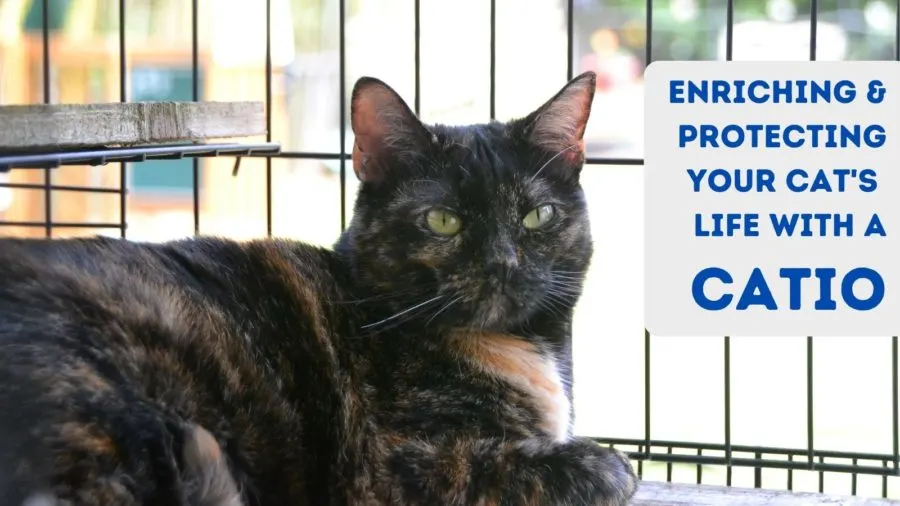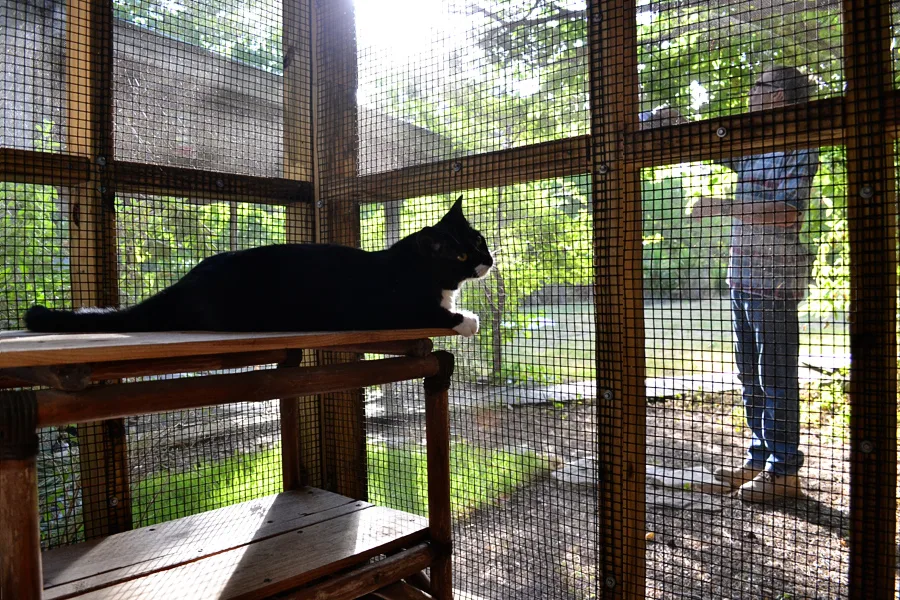Would you like to give your cat access to the outside world–but would like to keep your cat safe from vehicles, disease, coyotes, dogs and more? The answer is a catio, an enclosed patio for cats.

Catios can be as elaborate or as simple as you, your budget and your home dictate. From simple window boxes that can be installed in rental properties to custom built enclosures that function like a screened porch for cats, catios let your cat experience the outside world safely.
A catio gives cats the opportunity to enjoy the outdoors without the risks associated with roaming free, such as getting hit by a car or attacked by another animal. It allows indoor cats to enjoy the outdoors safely.
Types of Catios
If you’re considering adding a catio to your home, there are a few things to keep in mind. First, you’ll need to decide on the size and design of the space. Will it be attached to your house or will it be freestanding? How much space do you have? What kind of features would your cat like?
Pop-Up Cat Playpen
The simplest catio is a pop-up cat playpen. Like a child’s playpen, it pops open but has a top so your cat cannot jump out.
Pros:
- least expensive catio; some can be expanded with tunnels
- easy to move depending on weather, sun
- takes only a few minutes to pop up or break down
- easy to store
Cons:
- it’s not a self-serve type of catio; your cat can’t come and go as she likes
- you have to carry your cat to the cat playpen, creating a risk of your cat getting away
- it isn’t safe for non-supervised play since a large dog (or pet thief) could get through the playpen fabric
Cat Windowbox
A cat windowbox or catio windowbox sits, like you might guess, right in the window. You open the window, insert the windowbox then close the window to hold it in place (much like a window AC unit).
Some windowboxes are plexiglass; others contain wire so your cat gets the scent of outdoors. Cat windowboxes can be constructed (see above) or purchased like these from The Cat Solarium.
Pros:
- a cat windowbox is easy to install and doesn’t require a professional installer
- easy to move if you move
- most can be used in apartments and rentals
Cons:
- many have openings on each side between the windowbox and the window facing that you will need to securely close so your cat can’t escape
- cat windowboxes are small so your cat doesn’t have room to do much besides look out
- you will need to secure your window so a burglar can’t raise the window, remove the windowbox and have access into your home
Ready-Made Catios
Pre-built catios can be purchased (Amazon has quite a few) that stand outside a window and attach to the side of your house. Your cat enters through a cat door or open window. These can also serve as free-standing catios that you would carry your cat to for a few hours of use.
Pros:
- you can purchase a pre-made catio that can be moved when you move
- fairly budget friendly when compared to a custom catio
- will accommodate multiple cats
Cons:
- you will have to find a way to attach the cat enclosure to your home and prevent your cat from escaping between the two
- you will still need to install a cat flap or other means for your cat to get from your home to the catio safely
- doesn’t take into consideration your home’s structure
Custom Catios
A custom catio can be as simple as a screened-in porch or as elaborate as a multi-level enclosure complete with climbing structures and scratching posts to serve multiple cats. It is custom made to your specifications and house.
Pros:
- cats can come and go as they like, usually through a cat flap in your home
- you can add all types of enrichment activities: stairs, ramps, scratching posts and trees, you name it
- the catio can be as big as you like and can be built in conjunction with special features on your home, with walkways above or below windows, etc.
Cons:
- this is the most expensive catio option, especially if you need to hire a builder
- this is a permanent option that may or may not be attractive to a potential buyer, if you later sell your home
- this is not an option for renters
Our Catio

A few years ago, John constructed a catio for our cats, attaching it to our house.
As our regular readers know, we live in coyote country. We hear them every evening when they come down into the valley for water and for hunting. No one in our area has outdoor cats.
But many of our readers don’t know that we’re also surrounded by a protected bird preserve. In fact, some of the back portion of our land is an actual preserve with an easement so biologists can come onto the land for bird counts and to track and count two protected species: the Golden-cheeked Warbler and the Black-capped Vireo. We’re proud that through the years we’ve preserved the land to the point where it was natural enough that, when the preserve came to our region, that it was deemed a good habitat for the birds.
Between the coyotes and the bird preserve, we know our cats absolutely have to remain indoors, and we’re happy about that. We do, however, want to do all that we can do to enrich their lives and provide them activities.
One of the best additions we’ve made to our home is the catio, a small screen room especially for the cats. They access it through a cat flap in our storage room, coming out to the outdoors but with the protection of the indoors. We’ve placed several bird feeders in the yard directly in front of the catio so the cats can take part in some bird watching of their own without putting anyone at risk.
For much of the year, we have a traditional bird feeder, like the one seen in the photo above, where we feed primarily sunflower seed. We have many White-winged doves come to the feeder along with some Black-crested Titmice, Carolina Chickadees, Northern Cardinals, and Scrub Jays.
When spring comes, we’ll add a hummingbird feeder as well. These fast-flying birds come up from Mexico and Central America and will stay until early September, flitting around the feeder and entertaining our cats at the same time!
- 🎉 GIVEAWAY: Lord of the Pets Portrait of Your Cat! - November 26, 2024
- Review: Lord of the Pets Cat Portraits! - November 26, 2024
- Cat Adoption: FAQ You Might Have - June 28, 2024
